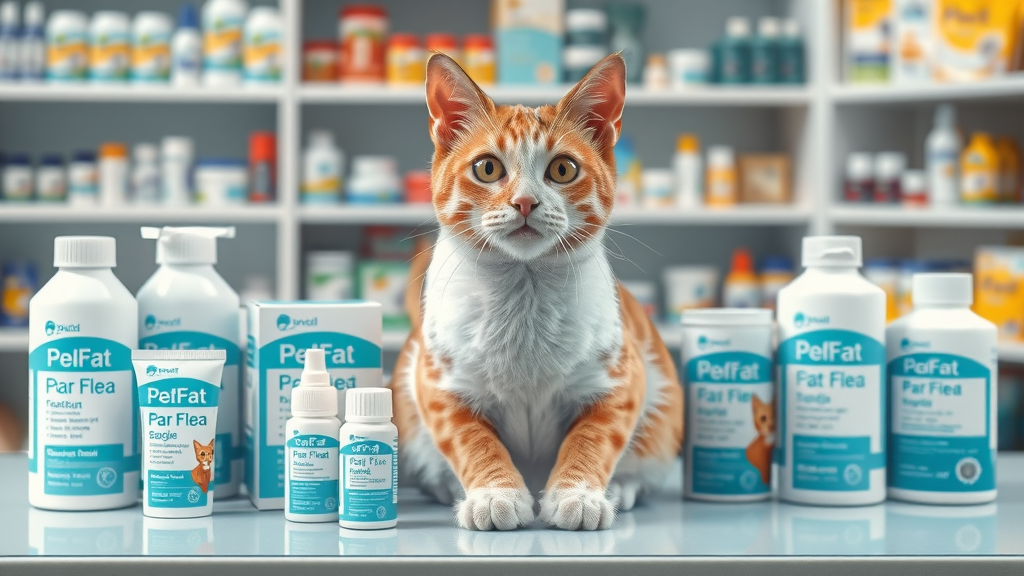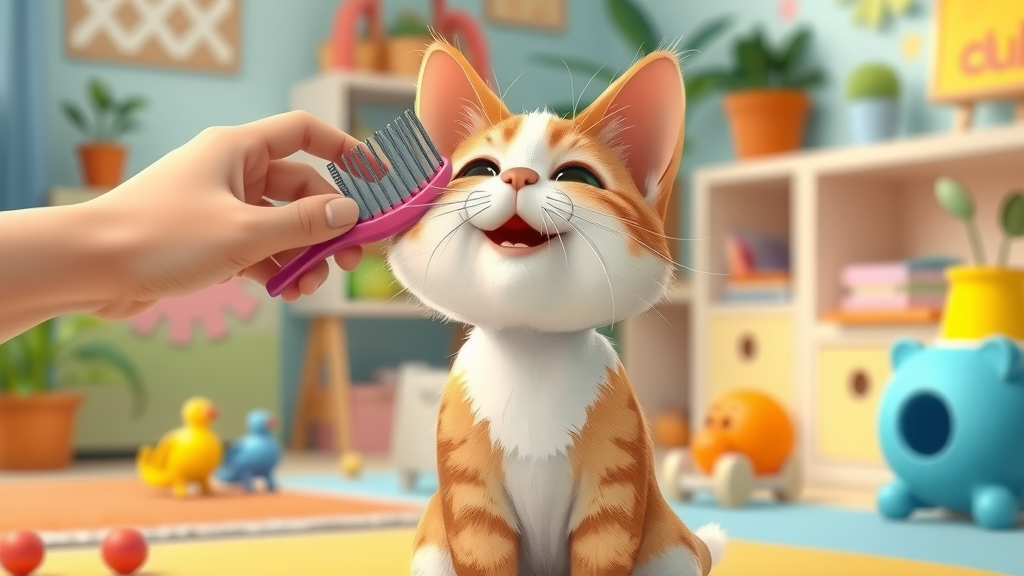Did you know? Just one female flea can lay up to 50 eggs a day, meaning a single flea problem can explode into a full-blown infestation faster than most cat owners realize! When it comes to cat fleas , time is of the essence. If you’ve found yourself asking, how do I treat fleas on my cat? , you’re in the right place. This guide covers everything you need to know to spot, kill, and rid your cat of fleas for good—along with practical, safe, and fast solutions to protect your pet and your home.
Fleas on Cats: Startling Facts Every Cat Owner Should Know About Flea Treatment
- Immediate flea and tick action is crucial to prevent rapid escalation of infestations and health risks for your cat.
- Cat flea infestations can spread exponentially in just days, thanks to the rapid flea life cycle and prolific egg-laying.
- From flea combs to vet-approved flea treatments , a variety of proven methods can quickly remove fleas and restore your cat’s health.

Spot the Signs: Identifying If Your Cat Has Fleas and Why Flea Control Matters
Recognizing the first hints that your cat has fleas is crucial for effective flea control and can spare your furry friend from discomfort, allergies, and even more serious problems. Fleas feed on the blood of your pet, cause flea bites , and can also transmit diseases and tapeworms. If ignored, the flea infestation can multiply, leading to a problem that affects not only your cat but your entire home—including carpets, bedding, and family members. Acting quickly at the earliest signs can rid your cat of fleas before things get out of hand.
Spotting a cat flea problem early means less stress for everyone. Cats suffering from fleas may display continuous scratching, biting at their skin, or even behavioral changes. The importance of prompt flea treatment can’t be overstated. Fleas are resilient and capable of surviving for months, so you’ll want to remove fleas as quickly as possible and prevent reinfestation using recommended products and techniques. Fast, informed action also protects against complications like skin infections or allergic reactions in sensitive cats.
How to Recognize Cat Fleas, Flea Bites, and Flea Dirt on Your Cat
- Flea bites: Look for small red bumps usually around the neck, belly, and back legs. Your cat may lick or scratch these spots often.
- Presence of flea dirt: Flea dirt appears as tiny black specks—often found in the fur, especially at the base of the tail or neck. Rub them with a damp tissue; if the specks turn reddish-brown, it’s digested blood.
- Excessive scratching and grooming: Cats with fleas will scratch, bite, or lick themselves more than usual.
- Behavioral changes: Restlessness, agitation, and irritability can stem from flea discomfort.
- Patchy hair loss: Persistent flea problems can cause bald patches, most often where your cat can reach to bite or groom.
How Do I Treat Fleas on My Cat? Step-by-Step Guide to Rid of Fleas Fast
Once you know your cat has fleas , acting swiftly is key to control the outbreak. Here’s how to remove fleas from your cat rapidly and safely, minimizing stress for both of you. Using the right techniques and products will help you rid your cat of fleas and start the process of full flea and tick control for your home and pets. Modern options work fast to kill adult fleas and limit the spread of flea eggs.
Follow this actionable step-by-step approach to ensure your cat—and your home—are on the path to being flea-free. For deep infestations, repeat these steps as needed and always finish by consulting your vet for ongoing flea control strategies.
Immediate At-Home Solutions: Using Flea Comb, Dish Soap, and Safe Flea Treatments
- Isolate your cat: Prevent the immediate spread of fleas by keeping your cat in a manageable space.
- Use a flea comb to remove fleas and flea dirt: Carefully run a fine-toothed flea comb through your cat’s fur, focusing behind ears and at the base of the tail. Drown combed fleas in soapy water to kill adult fleas .
- Bathing with vet-approved solutions: A gentle bath with flea shampoo or mild dish soap (for emergencies) helps remove surface fleas. Dry thoroughly and keep your cat warm.
- Applying topical or oral flea treatments: Select a reputable, vet-approved flea treatment labeled safe for cats. Topical and oral treatments typically start killing fleas within hours and work to halt the flea life cycle .
- Monitoring for effective flea control: Check your cat daily with a flea comb for a week following treatment. Look for recurrence of black specks, scratching, or behavioral changes.
"A single female flea can lay up to 50 eggs a day—acting fast is essential to protect your pet and home." – Leading Veterinarian
Choosing the Right Flea Treatment for Cats: Comparing Flea Treatments and Flea Control Products
With so many flea treatments available, it’s important to choose the best product for your cat’s needs. The right option will kill adult fleas quickly, halt further egg production, and provide lasting flea and tick protection. Some treatments act almost immediately, while others offer prolonged protection against reinfestation. Always read product labels and consult your veterinarian if you are unsure which treatment to use, especially for kittens or senior cats, to avoid anything that could be toxic to cats .

Product types range from flea collars and spot-on topicals to oral medications and flea shampoos. Some owners prefer natural or alternative methods, but it’s helpful to remember that not all solutions are equally effective—and some may only kill adult but not eggs or larvae. Let’s compare the most common types so you can make an informed decision to remove fleas and prevent future flea infestations .
| Treatment | How Fast Does It Work? | Protection Duration | Safety | Effectiveness in Removing Fleas |
|---|---|---|---|---|
| Topical Solutions | Within 12 hours | Usually 30 days | Generally safe when used as directed | Very high (kills adult fleas and some prevent eggs/larvae) |
| Oral Medications | Within 4–6 hours | 24 hours to 1 month | Needs correct dosing by weight | Extremely effective (kills adult fleas, rapid action) |
| Flea Collars | 1–2 days | Up to 8 months | Select collars approved for cats only | High for prevention; moderate for established infestations |
| Flea Shampoos | Immediate upon contact | Temporary (few days) | Some ingredients may be harsh for kittens/certain cats | Useful for initial removal, less for long-term protection |
Flea Collars, Topical Solutions, and Oral Medications: Pros, Cons, and Precautions
Flea collars offer long-lasting protection and are convenient for busy owners, but they may not resolve an active flea infestation as quickly as topical or oral medications. Always choose collars specifically marked safe for cats—some made for dogs can be toxic to cats and cause severe health issues. Collars work best for ongoing flea and tick prevention rather than immediate knockdown.
Topical flea treatments (spot-ons) are applied between your cat’s shoulder blades and can kill fleas within hours, breaking the flea life cycle and preventing the spread of flea eggs . Topical solutions are often a top choice to quickly remove fleas , but care must be taken to avoid incorrect dosing. Oral medications, usually prescribed by a veterinarian, tend to work even faster, circulating through your cat’s system to kill adult fleas that bite. These options are highly effective for cats with allergies or who are sensitive to direct skin applications. Always talk to your vet before starting oral meds for the first time.
Flea shampoos can immediately kill adult fleas on contact, but their effects tend to be short-lived unless supported by additional flea control . Shampoos can be useful for initial removal but should always be followed up with another form of long-term protection. Monitor for any allergic reaction or irritation, especially in kittens or cats with sensitive skin.
Removing Fleas Safely: When to Consult Your Vet About Flea and Tick Treatments
Certain flea and tick products require veterinary oversight, particularly if your cat is young, elderly, pregnant, or has other health issues. If over-the-counter or home remedies do not fully rid your cat of fleas, or if your pet shows signs of an allergic reaction (red skin, swelling, persistent scratching, lethargy), book an appointment with your veterinarian right away. Some cats may also develop sensitivity to topical agents, or you may need prescription-strength solutions to combat severe infestations.
Consulting a vet is also recommended if your cat is exhibiting other symptoms—like patchy hair loss, sores, or involvement of other household animals. Your vet can provide the most trusted, tailored flea treatments that break the entire flea life cycle and prevent further issues, offering peace of mind that you are doing what’s best for your feline friend.
How to Remove Fleas from Your Home for Complete Flea Control
Effective flea control extends beyond your cat—your home must also be treated to prevent a flea infestation from recurring. Flea eggs, larvae, and pupae can lurk in pet bedding, carpets, and furniture, causing repeat outbreaks even after you’ve managed to kill adult fleas on your pet. By addressing your environment, you’re attacking fleas at all stages of their life cycle , not just the visible adults. This holistic approach provides the best chance to rid your home of fleas completely.
- Launder pet bedding: Wash all pet bedding, blankets, and washable cat toys in hot water. Dry on high to kill flea eggs and larvae.
- Vacuum carpets and upholstery: Regular, thorough vacuuming helps remove adult fleas, eggs, and larvae. Discard vacuum bags immediately to prevent fleas from escaping.
- Use cat-safe household flea treatment sprays: Select sprays labeled for use around pets and avoid products toxic to cats . Treat all places your cat rests, including under furniture and baseboards.
- Treat all pets: For complete flea control , all animals in the home must be treated at the same time using appropriate products.

Natural and Alternative Flea Remedies: Dish Soap, Herbal Solutions, and Effectiveness
Some cat owners prefer to start with natural remedies or use them alongside traditional flea treatments . Options like dish soap baths and herbal sprays may help remove fleas temporarily, but it’s vital to be cautious and ensure any selected product is safe and non-irritating for cats. Most natural remedies are best suited for mild infestations or maintenance rather than as standalone treatments during a full-blown flea infestation .
Homemade remedies can play a role in your flea control plan, but be wary—unproven “DIY” concoctions or essential oils can be toxic to cats . Always do your research, and when in doubt, consult your veterinarian for guidance before trying new approaches, especially with kittens or cats with medical conditions.
Does Dish Soap Kill Fleas? Homemade Remedies to Remove Fleas on Cats

Dish soap can quickly break down the protective waxy layer on fleas, causing them to drown when immersed in water. For light infestations or emergencies when flea shampoo isn’t available, a single bath with unscented dish soap may help remove fleas from your cat’s fur. However, this method does not offer ongoing flea control and cannot prevent eggs from hatching. Use only a small amount of mild, fragrance-free dish soap and rinse thoroughly to minimize irritation.
For ongoing protection and to truly rid your cat of fleas , dish soap should only be considered as a first step until you acquire approved flea treatments . Avoid frequent dish soap baths, as they can dry out your cat’s sensitive skin. Always ensure your cat is dried and kept warm after any bath to avoid complications, and never use dish soap with harsh chemicals or added ingredients, which may be toxic to cats .
How to Prevent Future Cat Flea Infestations: Flea and Tick Prevention Strategies
- Regular use of a flea comb: Check your cat weekly to catch issues early and keep adult fleas at bay.
- Consistent use of prescribed flea control: Monthly flea and tick prevention—via topical, oral, or flea collars —keeps both adult fleas and flea eggs in check.
- Monitor outdoor exposure: Keep cats indoors as much as possible, or supervise outdoor activity to prevent reinfestation.
- Routine cleaning of living areas: Frequent vacuuming, laundering of bedding, and decluttering discourage flea infestations .

People Also Ask: What is the fastest way to get rid of fleas on a cat?
How Do I Treat Fleas on My Cat for Immediate Relief? Best Practices for Speedy Results
The fastest way to rid your cat of fleas is to use a combination of methods: start with a flea comb to manually remove fleas and flea dirt, follow with a bath using cat-safe dish soap or flea shampoo , and apply a reliable topical or oral flea treatment approved for cats. Be sure to clean your home and treat all pets to squash the flea life cycle . When in doubt, talk to your vet for the best rapid-response product for your specific situation.
Always check for black specks (flea dirt) and other signs of persistent fleas after treatment. Speed and consistency are key, especially if your cat has fleas and you want to keep your whole house flea-free.
People Also Ask: Can you treat fleas without a vet?
Flea Treatment Options at Home: Over-the-Counter vs. Veterinary Guidance
You can start to remove fleas at home using over-the-counter products like spot-ons, sprays, flea collars , and cleaning household areas. However, there are risks associated with incorrect dosing, use of flea treatments not designed for cats, or products that may be toxic to cats . Over-the-counter solutions can be effective for mild to moderate cases if directions are followed closely.
For heavy infestations, kittens, elderly cats, or if your cat has fleas and fails to respond to initial treatments, seek your vet’s advice. Vets can prescribe professional-grade medications with proven efficacy and safety, ensuring complete flea control with minimal risk to your pet.
People Also Ask: Does Dawn dish soap kill fleas?
Truth About Using Dish Soap for Cat Flea Control: Safety and Effectiveness
Yes, Dawn dish soap has been shown to kill fleas on contact when used carefully in a one-time bath. The soap breaks down the flea’s protective coating, but it does not address flea eggs or protect against new infestations. While safe in emergencies, frequent use can irritate your cat’s skin, so always follow up with a comprehensive flea treatment plan. Don’t rely on dish soap alone for long-term flea control .
People Also Ask: Do I need to treat my house if my cat has fleas?
Importance of Flea Control in Your Home: Thorough Steps to Remove Fleas from Your Environment
Treating your home is a must if your cat has fleas . Adult fleas lay hundreds of eggs that drop into carpets, furniture, and bedding, causing endless reinfestation if ignored. Along with medicating your cat, vacuum all surfaces, wash textiles, and use cat-safe sprays designated for household flea control . This comprehensive approach ensures you rid your home of fleas and protect your pets and family from future outbreaks.

Expert Tips and Proactive Measures for Rid of Fleas and Flea Control
- Stay vigilant—catch flea infestations early with regular checks.
- Maintain a flea treatment schedule for all pets in your household.
- Combine at-home cleaning, flea treatment products, and professional guidance for complete flea control .
- Consult your veterinarian whenever you have concerns about product safety, resistant infestations, or your cat’s wellbeing.
Frequently Asked Questions: Flea Treatments, Flea Bites, and Flea Control for Cats
How often should I apply flea treatment to my cat?
Most flea treatments are designed for monthly application for ongoing flea and tick control. Some oral medications may need dosing every 1–3 months, while flea collars can last up to 8 months. Always follow instructions on the product and coordinate with your veterinarian for your cat’s individual needs.
What are the risks of untreated cat fleas?
Untreated cat fleas can cause severe itchiness, allergic reactions, skin infections, and even anemia—especially in kittens or older cats. Fleas may transmit tapeworms and other diseases if left unchecked. Quick, thorough treatment protects both your cat and your household from long-term consequences.
Can indoor cats get flea infestations?
Yes, indoor cats can still become infested with fleas. Fleas may enter on shoes, clothing, or other pets, or come through windows and doors. Routine flea control and regular home checks are key even for cats that stay primarily inside.
Watch our video guide for a visual walkthrough of the fastest and safest steps to remove fleas from your cat, from initial combing to choosing the right products.
See how different flea treatments work in real time, compare their speed, coverage, and safety, and choose what’s best for your cat’s ongoing comfort and health.
Ready to Keep Your Cat Flea-Free? Subscribe for the Latest Pet Health Advice
We can’t teach your dog to sit — but we can deliver great pet advice every month. 🐕 Subscribe to the newsletter and fetch some fun!
To effectively treat fleas on your cat, it’s essential to address both your pet and its environment. Begin by using a fine-toothed flea comb to remove adult fleas and flea dirt from your cat’s fur. Bathing your cat with a vet-approved flea shampoo can also help eliminate existing fleas. Following the bath, apply a veterinarian-recommended topical or oral flea treatment to kill any remaining fleas and prevent future infestations. Always consult your veterinarian to choose the most appropriate and safe flea treatment for your cat.
In addition to treating your cat, it’s crucial to eliminate fleas from your home to prevent reinfestation. Vacuum carpets, rugs, and upholstery daily, focusing on areas where your cat spends the most time. Wash your cat’s bedding and any fabric items they frequently use in hot water to kill flea eggs and larvae. Using household flea sprays or foggers that contain insect growth regulators (IGRs) can help disrupt the flea life cycle in your home. Ensure you follow the product instructions carefully and keep your cat away from treated areas until it’s safe.
For more detailed information on flea control in cats, consider reading “Flea Control in Cats” by VCA Animal Hospitals, which provides comprehensive insights into available products and home treatment methods. Additionally, “Protect Your Cat and Home from Fleas” by WebMD offers valuable tips on preventing and treating flea infestations effectively. These resources can guide you in selecting the best flea treatment options and implementing effective home control measures to keep your cat and household flea-free.
 Add Row
Add Row  Add
Add 




Write A Comment